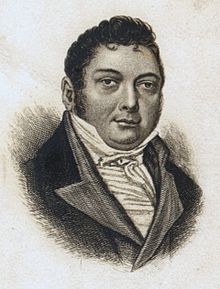Matthew Murray
| Matthew Murray | |
|---|---|
 |
|
| Born | 1765 Newcastle upon Tyne |
| Died | (aged 60) |
| Resting place | Holbeck, Leeds |
| Nationality | English |
| Citizenship | British |
| Occupation | Engineer Millwright Machine tool builder Entrepreneur Manager |
| Known for | Steam engines Locomotives Machine tools Textile machinery |
| Notable work |
Round Foundry Hypocycloidal engine Salamanca locomotive 2-cylinder marine engine Hydraulic press |
Matthew Murray (1765 – 20 February 1826) was an English steam engine and machine tool manufacturer, who designed and built the first commercially viable steam locomotive, the twin cylinder Salamanca in 1812. He was an innovative designer in many fields, including steam engines, machine tools and machinery for the textile industry.
Little is known about Matthew Murray's early years. He was born in Newcastle upon Tyne in 1765. He left school at fourteen and was apprenticed to be either a blacksmith or a whitesmith. In 1785, when he concluded his apprenticeship, he married Mary Thompson (1764–1836) of Whickham, County Durham. The following year he moved to and began work as a journeyman mechanic at the flax mill of John Kendrew in Darlington, where the mechanical spinning of flax had been invented.
Murray and his wife, Mary, had three daughters and a son, also called Matthew.
In 1789, due to a lack of trade in the Darlington flax mills, Murray and his family moved to Leeds to work for John Marshall, who was to become a prominent flax manufacturer. John Marshall had rented a small mill at Adel, for the purpose of manufacture but also to develop a pre-existing flax-spinning machine, with the aid of Matthew Murray. After some trial and error, to overcome the problem of breakages in the flax twine during the spinning of the flax, sufficient improvements were made to enable John Marshall to undertake the construction of a new mill at Holbeck in 1791, Murray was in charge of the installation. The installation included new flax-spinning machines of his own design, which Murray patented in 1790. In 1793 Murray took out a second patent on a design for "Instruments and Machines for Spinning Fibrous Materials". His patent included a carding engine and a spinning machine that introduced the new technique of "wet spinning" flax, which revolutionised the flax trade. Murray maintained the machinery for Marshall's mills and made improvements that pleased his employer. At this stage it seems that Murray was the chief engineer in the mill.
...
Wikipedia
